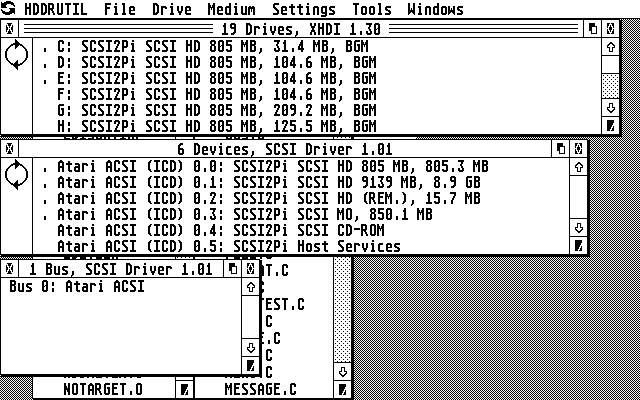With HDDRIVER SCSI2Pi and BlueSCSI support all SCSI commands with the ACSI bus. With the MegaSTE's internal host adapter or external non ICD-compatible adapters there are no restrictions (no 1 GB limit) with respect to the drive capacity.
The internal host adapter of the MegaSTE has several limitations: It only supports a single drive, whose SCSI ID is set by DIP switches. In addition, it can only access the first GB of a drive. For HDDRIVER setups with SCSI2Pi all these limitations are a thing of the past. Up to 8 devices can be added to the MegaSTE's host adapter. Hard drives, CD-ROM drives, a SCSI-to-uSB bridge and a real-time clock with daylight saving time support, for instance. HDDRIVER supports multiple so-called LUNs (SCSI sub-units).
With SCSI2Pi LUNs are defined by appending the LUN number to the device ID, e.g.:
>s2p -i 0:0 BOOT_DRIVE_FILE_FOR_LUN_0.hds -i 0:1 CD_ROM.iso -i 0:7 services
Note that ACSI only supports the LUNs 0-7, whereas SCSI supports the LUNs 0-31, e.g. with a TT or Falcon.
A Raspberry Pi Zero WH or Zero 2 W with a PiSCSI board can easily be accomodated in a MegaSTE instead of a hard drive. The time that a MegaSTE with TOS 2.06 waits before attempting to boot is sufficient to launch the SCSI2Pi service on an internally installed Raspberry Pi.
Before turning off the MegaSTE, the Pi can be shut down using the SCSI Control app or the SCSI2Pi client tools. These tools also allow SCSI2Pi to be used as real-time clock with daylight saving time support. This is useful, for example, when the battery of the MegaSTE's clock is empty, or just to have daylight saving time support.
The screenshot shows devices emulated by SCSI2Pi at the internal MegaSTE host adapter. With HDDRIVER up to 8 devices and drives much bigger than 1 GB are no problem at all.

Important to know: The DaynaPort drivers for STiNG and MiNT unfortunately only support LUN 0. This means that the DaynaPort emulation cannot be used with the internal host adapter of the MegaSTE in case LUN 0 is already being used by an emulated hard drive. (TOS can only boot from LUN 0.)
It is probably not a big effort to extend the DaynaPort drivers with LUN support. On GitHub there is code for the SCSI Driver, which automatically detects a particular device independent of its SCSI ID or LUN.
For HDDRIVER there is a beta version of a program for the AUTO folder, which maps ACSI ID 6 to LUN 6 of ACSI device 0. That way the emulated DaynaPort can use ID 0 LUN 6, but the drivers see the device as ID 6 LUN 0. Users of HDDRIVER 12 who would like to test this beta version please send me an email.